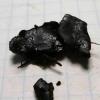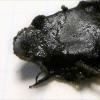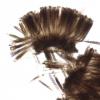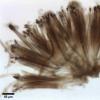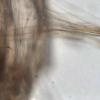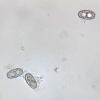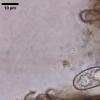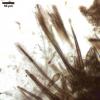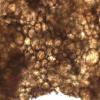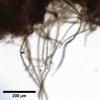
12-11-2025 09:25
 Viktorie Halasu
Viktorie Halasu
Hello, I need help with a pale terrestric Pseudom

11-11-2025 20:16
Bohan JiaHi, lastly I have found these tiny yellow decayin

09-11-2025 13:20
Hello.A tiny ascomycete, appearing as erupting gra

08-11-2025 00:29
 Francois Guay
Francois Guay
I found this species in Quebec, Canada, on herbace
Black is beautiful … but not easy to determine!
François Bartholomeeusen,
29-11-2021 17:39
After several microscopic examinations, I found a saucer-shaped, shiny, pitch-black fruiting body among the leftover debris. It looked like a piece of black plastic. Apparently all parts (spore, asci, paraphyses, excipulum) were coated with a black pigment. Even the smell was very special, it reminded me of dark chocolate, five years after its expiry date!
I could not remember where I had found it, and the dish seemed damaged and not really fresh. Paraphyses and asci seemed to be sticking together.
Could this be Trichophaea abundans (the black form)?
Any help is appriciated,
François Bartholomeeusen
FRB: diameter +/- 20 mm
Spores: (19.2) 20.7-23.4 (23.6)×(10.8) 11-12.3 (13.1) µm; Me = 22.1 × 11.7 µm; Qe = 1.9;
Asci: 250 x 18 µm;
Paraphyses: filiform, sometimes branches at the top;
Hairs at the margin: 370 x 16 µm; excipular hairs: 150 x15 µm;
Anchor hyfen: with croziers
IKI: no reaction
Nicolas VAN VOOREN,
29-11-2021 19:07

Re : Black is beautiful … but not easy to determine!
Ecology?
François Bartholomeeusen,
29-11-2021 20:11
Re : Black is beautiful … but not easy to determine!
Hi Nicolas,
That's the problem, that day we explored boggy meadows with peat moss and Sphagnum. Also the banks of a lake with clay deposits. It was in Flanders, so at sea level and normally very sandy soil with deciduous and pine trees. Here and there was also burned ground with charred wood. But as I only found the fruiting body at home, in the rubbish from previous investigations, I don't know where on which substrate it was attached. We also found: Peziza vesiculosa, Humaria hemisphaerica, Hygrocybe miniata, Geastrum lageniforme, Geoglossum umbratile.
Hopefully this can help?
Greetings
That's the problem, that day we explored boggy meadows with peat moss and Sphagnum. Also the banks of a lake with clay deposits. It was in Flanders, so at sea level and normally very sandy soil with deciduous and pine trees. Here and there was also burned ground with charred wood. But as I only found the fruiting body at home, in the rubbish from previous investigations, I don't know where on which substrate it was attached. We also found: Peziza vesiculosa, Humaria hemisphaerica, Hygrocybe miniata, Geastrum lageniforme, Geoglossum umbratile.
Hopefully this can help?
Greetings
François Bartholomeeusen,
02-12-2021 14:33
Re : Black is beautiful … but not easy to determine!
So, no one can point me in the right direction?
Kind regards,
François
Kind regards,
François

